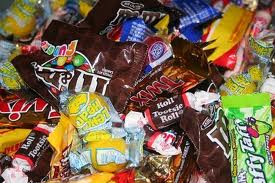The excitement is building towards Halloween and getting dressed up, and as parents, we know that this also means more candy than our little ones really need. It’s always a challenge to figure out what to do with leftover candy and to try and get your little ghosts and goblins on board with candy disposal.
How about putting all that extra candy to good use this Halloween by conducting some candy science experiments?
Candy comes in all shapes and sizes. It also comes in a variety of colors. You and your children are most likely aware that the coloring on candies, such as Skittles and M&M’s, is artificial coloring. But did you know that the color you see is actually made up of a variety of different dyes? In this months edition of “Let’s Discover” we will be uncovering the hidden colors in your Halloween candy! Have fun, and remember, don’t eat your experiment!

Materials:
• A rectangle of coffee filter paper
• Dyed candy such as M&Ms, Skittles, or Reese’s Pieces (5 different colors)
• A tall glass
• A pencil
• Aluminum pie plate
• Toothpicks
• Salt
- What to do:
1. Collect your materials.
2. On the bottom of your coffee filter (about ¼ inch up from the bottom), make 5 dots with your pencil, equally spaced out.
3. Label each dot corresponding to the color that will be placed there (i.e. B for blue, G for green).
4. Make 5 separate puddles of water on your pie plate (about 2-3 drops each). Ensure the puddles don’t mix.
5. Place a different color candy in each puddle.
6. Wait 1-2 minutes for the color of the candy to come off into the water.
7. Dip a toothpick into a colored puddle and dab it onto the pencil dot corresponding to that color (i.e. drop the blue colored water on the dot labeled B).
8. Repeat step 7 for all colors using a new toothpick each time so that the colors don’t get mixed together (this would give you false results).
9. Let the drops dry completely.
10. Mix your salt solution by placing ⅛ teaspoon of salt in 3 cups of water.
11. Fill your glass with ½ inch of salt-water solution.
12. Suspend your coffee filter in the glass so that the water line is below your colored dots.
13. Let the water work its way up your coffee filter until it is about ¼ inch from the top
14. Let dry completely.
15. Check it out!
Why it works?
Why does the water travel up the paper? Water has tiny channels throughout it that sucks the water up. Water drops sticks together so they form a chain of water drops that move up through the paper. This is called capillary action. The capillary action draws the liquid up the paper, through the dots and towards the upper edge of the paper. The pigments will become separated as the liquid moves through the paper.
Why do the colors separate? Each color is made up of a different combination of dye colors. The dyes that make up a certain color are not present in the same concentration. As such, the colors will move up the paper until that color runs out of dye. On your resulting coffee filter chromagraph, the color that travels up the highest represents the dye that is most concentrated in the original candy color.
M&M brown works especially well–the different dyes separate out into a rainbow.
You can try this experiment with anything that contains dye, including juice, markers, or ballpoint pens (that’s why it’s better to mark your labels with pencil).

Questions to ask your child:
- Which candies contained the same dyes? (These are the candies that have corresponding bands of color).
- Which candies contained multiple dyes? (These are the candies that have more than one band of color)
- Can you match any of the colors with the names of the dyes listed in the ingredients list for the candies?
- You can try this experiment with markers, food coloring, and powdered drink mixes. You can compare the same color of different candies too. Do you think the pigments in green M&M’s and Skittles are the same? How can you use paper chromatography to find the answer?
For more great things to discover – visit the Discovery Centre on Barrington Street in Halifax, check out their website or join them on facebook.





